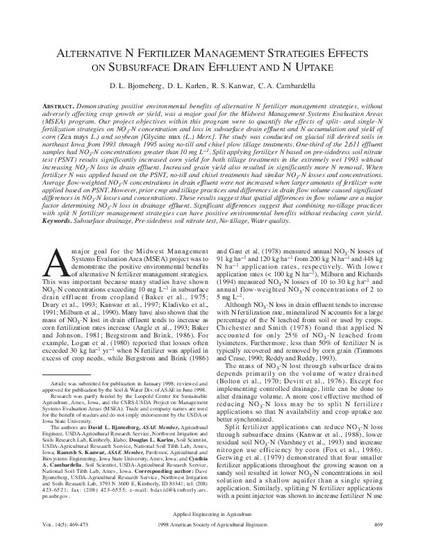
Demonstrating positive environmental benefits of alternative N fertilizer management strategies, without adversely affecting crop growth or yield, was a major goal for the Midwest Management Systems Evaluation Areas (MSEA) program. Our project objectives within this program were to quantify the effects of split- and single-N fertilization strategies on NO3-N concentration and loss in subsurface drain effluent and N accumulation and yield of corn (Zea mays L.) and soybean [Glycine max (L.) Merr.]. The study was conducted on glacial till derived soils in northeast Iowa from 1993 through 1995 using no-till and chisel plow tillage treatments. One-third of the 2,611 effluent samples had NO3-N concentrations greater than 10 mg L–1. Split applying fertilizer N based on pre-sidedress soil nitrate test (PSNT) results significantly increased corn yield for both tillage treatments in the extremely wet 1993 without increasing NO3-N loss in drain effluent. Increased grain yield also resulted in significantly more N removal. When fertilizer N was applied based on the PSNT, no-till and chisel treatments had similar NO3-N losses and concentrations. Average flow-weighted NO3-N concentrations in drain effluent were not increased when larger amounts of fertilizer were applied based on PSNT. However, prior crop and tillage practices and differences in drain flow volume caused significant differences in NO3-N losses and concentrations. These results suggest that spatial differences in flow volume are a major factor determining NO3-N loss in drainage effluent. Significant differences suggest that combining no-tillage practices with split N fertilizer management strategies can have positive environmental benefits without reducing corn yield.
Available at: http://works.bepress.com/douglas_karlen/4/

This article is from Applied Engineering in Agriculture 14 (1998): 469–473, doi:10.13031/2013.19416.